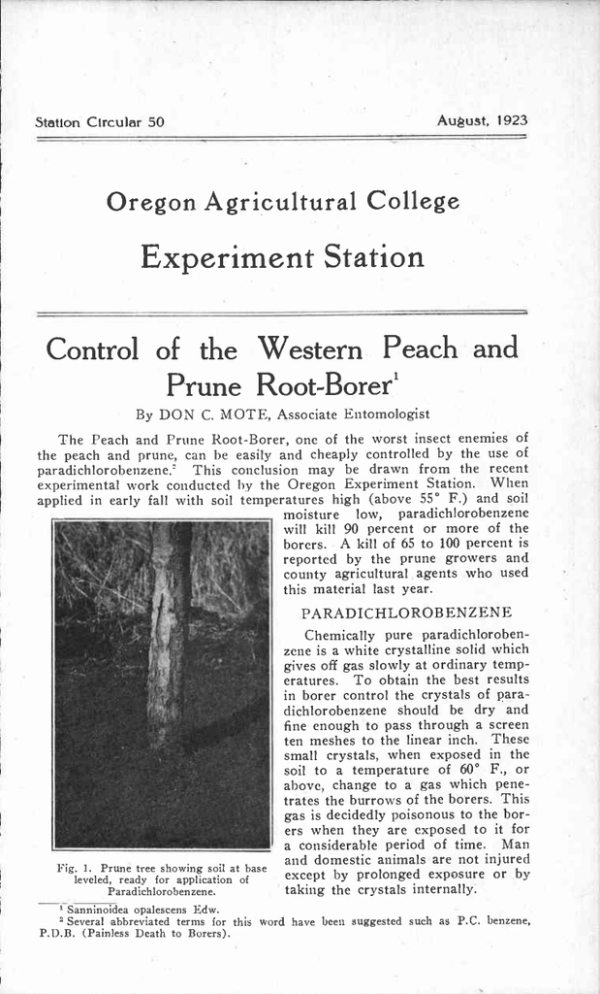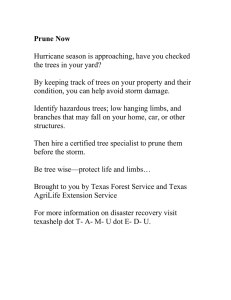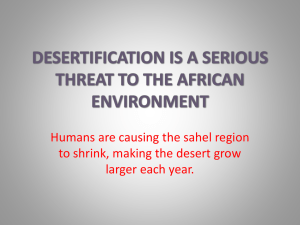Experiment Station Control of the Western Peach and Prune Root-Borer' Oregon Agricultural College
advertisement

Auut, Station Circular 50 1923 Oregon Agricultural College Experiment Station Control of the Western Peach and Prune Root-Borer' By DON C. MOTE, Associate Entomologist The Peach and Prune Root-Borer, one of the worst insect enemies of the peach and prune, can be easily and cheaply controlled by the use of paradichlorobenzenc. This conclusion may be drawn from the recent experimental work conducted by the Oregon Experiment Station. When applied in early fall with soil temperatures high (above 55° F.) and soil moisture low, paradichlorobenzene will kill 90 percent or more of the borcrs. A kill of 65 to 100 percent is reported by the prune growers and county agricultural agents who used this material last year. PARADICHLOROBENZENE Chemically pure paradichiorobenzene is a white crystalline solid which gives off gas slowly at ordinary temperatures. To obtain the best results in borer control the crystals of paradichlorobenzene should be dry and fine enough to pass through a screen ten meshes to the linear inch, These small crystals, when exposed in the soil to a temperature of 600 F., or above, change to a gas which penetrates the burrows of the borers. This gas is decidedly poisonous to the bor- ers when they are exposed to it for a considerable period of time. Man Fig. 1. Prune tree showing soil at base leveled, ready for application of Paradichlorobenzene, ° Sanninoidea opalescens Edw. and domestic animals are not injured except by prolonged exposure or by taking the crystals internally. 2 Several abbreviated terms for this word have beets suggested such as P.C. beazene. P.D.B. (Painless Death to Borers). MET 1-TOD OF APPLICATION Level off the surface of the soil about the base of the tree, but avoid disturbing the soil below the surface. Remove all large masses of gum that may be present at the base of the tree. Having prepared the soil, proceed to sprinkle the finely ground crystals in a ring around the base of the tree. This should form a circle about one inch wide and about two inches distant from the tree trunk. This part of the treatment should be done carefully. If the material is placed too far from the base of the tree the toxic effect of the gas is greatly lessened. On the other hand if it is placed too near, injury to the tree is likely to result. As soon as the paradichlorobenzene has been properly distributed around the tree, it should be carefully covered with a few shovels of loose earth, and the mound so formed should be well packed over the material. The first shovel of earth placed above the "death ring' should be finely divided and carefully placed on top of the crystals in order that the position of the crystals will not be disturbed. TIME OF APPLICATION The most satisfactory time to make the application of paradichloro- benzene is from August 15 to September 15. It is desirable to delay the treatment to as late a date as weather conditions permit in order to avoid reinfestation from moths which may be flying, and to allow the worms to collect about the crown of the tree. A sufficient time, however, must be allowed for the gas to act before unfavorable weather conditions set in. If this treatment is to be effective the soil temperature must be 550 F. or higher for a period of ten days or more after the material is applied, and the soil must be reasonably dry during this time. DOSAGE From three-fourths to one ounce of the paradichlorobenzene is sufficient for an ordinary tree six years of age and older. The application of the material to younger trees may injure them and is not advised. A measure holding just the required amount is convenient foc use in the orchard. INFLUENCE OF SOIL TYPES So far as present tests and observation go, the influence of soil type on the effectiveness of paradichlorobenzene has imposed only a relatively slight limitation. Mr. B. W. Cooney, Douglas County Agricultural Agent, reports the treatment effective upon most all types of soil save the one commonly known as a loose fern soil. Fig. 2. Prune tree showing the ring of Paradichlorobenzene in place. Even upon this soil a 35 percent kill was obtained. INJURY TO TREES Trees six years old and above have shown no ill effects from the treatment. Trees under six years have at times been injured and the extent of injury seemed to depend upon the duration of the exposure, the age of the tree, and the development of the epidermal and cork layers of the bark. The younger the tree, therefore, the more susceptible it is to burning by the gas. Although fumigation of younger trees is not advised, some growers are assuming the risk and fumigating their three-, four-, and five-year old trees, figuring that the loss of a few trees costs less than the damage the borers, if left uncontrolled, would do to the entire orchard. We trust we will have more definite information later on the effect of the gas on young trees. BORERS ABOVE GROUND LEVEL NOT KILLED The application of parachlorobenzene will kill only the borers situated below the level of the mound. Because of the fact that the western prune root-borer displays a tendency to work high up on the trunks of the trees, some growers have adopted the plan of raising the soil level around the tree several inches before applying the "death ring" of crystais. This plan may be effective for the borers working in the tree several inches above the soil level. Paradichiorohenzene is, of course, not effective against those bOrers working high upon the trunks and branches. Furthermore, it has been observed that fiatheaded borers located beneath the level of the mound containing the crystals have not been killed. SUPPLEMENTAL CONTROL Because of the danger in using the gas treatment on young trees a repellent whitewash is advised. Many Oregon growers are supplementing the paradichlorobenzene treatment on the older trees as well, through the use of repellent washes. The naphthalene whitewash, properly applied, has given good results in the Station's experimental tests and good reports Fig. 3. Prune tree with the soil mounded have come from commercial growers and packed over the Paradichlorobenzene. who have used the whitewash. WASH NO. 1 Rock lime ........ Salt (rock salt)5 Rice boiled (cook to a thin paste) Casein (powdered) Naphthalene flakes '4 bushel 2 3 2 5 quarts pounds pounds pounds Where rabbits are a pest the use of salt in the whitewash appears to increase the extent of their injury. The rabbits being salt hungry attack the trees to which the wash has been applied. Slake the lime in a vessel of sufficient capacity to permit adding other Dissolve the salt in warm water and add the warm salt ingredients. water and warm rice paste to the freshly slaked lime while still fairly hot. Allow solution to cool. Then sift casein slowly into the cool white- wash while stirring. Now let the whitewash stand for two or three days, covering container to prevent contamination with dust and dirt. Finally, sift the naphthalene through a coarse screen to remove the lumps and add while stirring. Add water to make a whitewash the consistency of paint, if wash is to be applied with brush. If to be applied as a spray thin a little more and strain carefully while filling the spray tank. WASH NO. 2 Quicklime Casein 8 Copper sulfate Flake naphthalene Water to form a thick paint. pounds y pound '/ pound 1 pound Slake the lime in a fair-sized container. Dissolve the copper sulfate in a small amount of water (best to dissolve the day before needed). Add this copper-sulfate solution to the slaking lime. Add the casein and naphthalene as in wash No. 1. The amounts given in wash No. 2 are sufficient for about fifteen trees from four to six inches in diameter. Preliminary to applying the wash scrape away the loose surface soil with an old hoe. The wash may then be applied with a regular whitewash brush or it may be sprayed on the tree. Where using a sprayer cut down the pressure to about twenty-five pounds. Apply the wash from the main crotch down to the ground, puddling the wash at the soil surface. TIME OF APPLICATION The first application of the naphthalenc wash should be made during the last week of June or the first week of July. Station tests indicate that a second application is advisable in heavily infested orchards. This should be made during mid-August. On young trees just from the nursery the wash is applied by some growers earlier than the dates given in order to protect the tender trees from sun scald. Although the grower thus obtains protection from sun scald, which is exceedingly important, he loses to a considerable degree thc effectiveness of the wash as repellent later on when the moths are flying. TESTS TO CONTINUE Though sufficient information is at hand to warrant the recommendation of paradichlorobenzene and naphthalene whitewash for combating the prune root-borer, yet it should be borne in mind that the treatment is comparatively new under Oregon conditions. The Station, therefore, is continuing its investigations with a view to obtaining new information and improving the methods of application.






